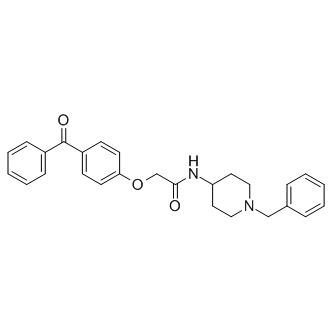All AbMole products are for research use only, cannot be used for human consumption.

AdipoRon is a novel, and orally bioavailable adiponectin receptor agonist with KD of 1.8 and 3.1 μM for AdipoR1 and AdipoR2, respectively.
AdipoRon (50 μM) dose-dependently attenuates the expression of TNF-α and TGF-β1 in the L02 cells. AdipoRon exhibits significant and dosage-dependent growth suppression on macrophages. AdipoRon treatment significantly improves cardiac functional recovery after reperfusion, and inhibits post-MI apoptosis.
AdipoRon (50 mg/kg, i.v.) cuases significant phosphorylation of AMPK in skeletal muscle and liver of wild-type mice but not Adipor1−/− Adipor2−/− double-knockout mice[1]. AdipoRon (0.02, 0.1, and 0.5 mg/kg, i.g.) alleviates D-GalN induced hepatotoxicity in mice, and prevents hepatic architecture distortion against D-GalN challenge.
| Cell Experiment | |
|---|---|
| Cell lines | DG granule cells |
| Preparation method | A baseline recording of DG granule cells from WT mouse brain slices was first made followed by bath application of 15 μM AdipoRon, an AdipoR agonist that binds to both AdipoR1 and AdipoR2 with comparable high affinities. In response to depolarizing current injections (300 ms), AdipoRon treatment decreased the excitability of DG granule neurons, causing reduced number of action potentials elicited by current injections (60–90 pA), increased rheobase current and a more negative resting membrane potential without changing other membrane properties including input resistance, action potential threshold, fAHP and action potential waveforms. |
| Concentrations | 15 μM |
| Incubation time | 24 h |
| Animal Experiment | |
|---|---|
| Animal models | Mice |
| Formulation | DMSO |
| Dosages | 50 mg/kg |
| Administration | oral |
| Molecular Weight | 428.52 |
| Formula | C27H28N2O3 |
| CAS Number | 924416-43-3 |
| Solubility (25°C) | DMSO 55 mg/mL |
| Storage |
Powder -20°C 3 years ; 4°C 2 years In solvent -80°C 6 months ; -20°C 1 month |
| Related Products |
|---|
| L-Lactic acid lithium
L-Lactic acid lithium is a lithium salt of L-Lactic acid with certain bioconductive properties. L-Lactic acid can be used as a precursor for the production of bioplastic polymer polylactic acid. |
| Lithium lactate
Lithium lactate (Lithium 2-hydroxypropanoate) is a kind of biological materials or organic compounds that are widely used in life science research. Lithium lactate is a biochemical reagent which can be used for the determination of lactic acid. |
| Lithium stearate
Lithium stearate (Stearic acid lithium) is a compound that forms vesicles in reaction with silver nitrate, thereby changing the reaction kinetics of the nucleation and self-assembly process of silver stearate. |
| cyclo(Ala-Ile)
cyclo(Ala-Ile) is a biochemical material that can be used in scientific research. |
| Myoglobin (from equine skeletal muscle)
Myoglobin is a small molecular pigment protein formed by binding globin to Heme, which can be reversibly bound to oxygen to form MbO2, MbO2 is called oxymyoglobin, and Mb is called deoxymyoglobin. Myoglobin has the role of transporting and storing oxygen in muscle cells. |
All AbMole products are for research use only, cannot be used for human consumption or veterinary use. We do not provide products or services to individuals. Please comply with the intended use and do not use AbMole products for any other purpose.


Products are for research use only. Not for human use. We do not sell to patients.
© Copyright 2010-2024 AbMole BioScience. All Rights Reserved.
